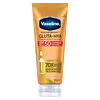Sunscoop Invisible Body Sunscreen SPF 60 PA++++ Versus Vaseline Gluta-Hya Serum Burst Luminous Defense Sunscreen SPF 50
What's inside
What's inside
 Key Ingredients
Key Ingredients

 Benefits
Benefits

 Concerns
Concerns

 Ingredients Side-by-side
Ingredients Side-by-side

Caprylic/Capric Triglyceride
MaskingC12-15 Alkyl Benzoate
AntimicrobialCyclopentasiloxane
EmollientEthylhexyl Methoxycinnamate
UV AbsorberOctocrylene
UV AbsorberEthylhexyl Salicylate
UV AbsorberButyl Methoxydibenzoylmethane
UV AbsorberPassiflora Edulis Seed Oil
EmollientCoco-Caprylate
EmollientArgania Spinosa Kernel Oil
EmollientButyrospermum Parkii Oil
EmollientGossypium Herbaceum Seed Oil
Skin ConditioningMacadamia Ternifolia Seed Oil
EmollientCamellia Oleifera Leaf Extract
AstringentChamomilla Recutita Oil
MaskingAloe Barbadensis Sprout
HumectantAcorus Calamus Root Oil
PerfumingCommiphora Myrrha Oil
MaskingOlea Europaea Fruit Oil
MaskingCinnamomum Zeylanicum Leaf Oil
MaskingOryza Sativa Germ Extract
EmollientGardenia Taitensis Flower Extract
Skin ConditioningCitrus Aurantium Dulcis Peel Oil
MaskingBHT
AntioxidantTocopheryl Acetate
AntioxidantCaprylic/Capric Triglyceride, C12-15 Alkyl Benzoate, Cyclopentasiloxane, Ethylhexyl Methoxycinnamate, Octocrylene, Ethylhexyl Salicylate, Butyl Methoxydibenzoylmethane, Passiflora Edulis Seed Oil, Coco-Caprylate, Argania Spinosa Kernel Oil, Butyrospermum Parkii Oil, Gossypium Herbaceum Seed Oil, Macadamia Ternifolia Seed Oil, Camellia Oleifera Leaf Extract, Chamomilla Recutita Oil, Aloe Barbadensis Sprout, Acorus Calamus Root Oil, Commiphora Myrrha Oil, Olea Europaea Fruit Oil, Cinnamomum Zeylanicum Leaf Oil, Oryza Sativa Germ Extract, Gardenia Taitensis Flower Extract, Citrus Aurantium Dulcis Peel Oil, BHT, Tocopheryl Acetate
Water
Skin ConditioningEthylhexyl Methoxycinnamate
UV AbsorberGlycerin
HumectantNiacinamide
SmoothingButyl Methoxydibenzoylmethane
UV AbsorberGlutathione
Sodium Hyaluronate
HumectantRetinyl Palmitate
Skin ConditioningHelianthus Annuus Seed Oil
EmollientGlycine
BufferingCystine
MaskingSodium PCA
HumectantPetrolatum
EmollientTriethanolamine
BufferingPhenoxyethanol
PreservativeDimethicone
EmollientCyclopentasiloxane
EmollientAcrylates/C10-30 Alkyl Acrylate Crosspolymer
Emulsion StabilisingParfum
MaskingMethylparaben
PreservativePropylparaben
PreservativeStyrene/Acrylates Copolymer
Disodium EDTA
Coco-Glucoside
CleansingBHT
AntioxidantBenzoic Acid
MaskingCitric Acid
BufferingPotassium Hydroxide
BufferingPotassium Carbonate
BufferingTocopherol
AntioxidantPotassium Chloride
Iron Oxides
Water, Ethylhexyl Methoxycinnamate, Glycerin, Niacinamide, Butyl Methoxydibenzoylmethane, Glutathione, Sodium Hyaluronate, Retinyl Palmitate, Helianthus Annuus Seed Oil, Glycine, Cystine, Sodium PCA, Petrolatum, Triethanolamine, Phenoxyethanol, Dimethicone, Cyclopentasiloxane, Acrylates/C10-30 Alkyl Acrylate Crosspolymer, Parfum, Methylparaben, Propylparaben, Styrene/Acrylates Copolymer, Disodium EDTA, Coco-Glucoside, BHT, Benzoic Acid, Citric Acid, Potassium Hydroxide, Potassium Carbonate, Tocopherol, Potassium Chloride, Iron Oxides
Ingredients Explained
These ingredients are found in both products.
Ingredients higher up in an ingredient list are typically present in a larger amount.
BHT is a synthetic antioxidant and preservative.
As an antioxidant, it helps your body fight off free-radicals. Free-radicals are molecules that may damage your skin cells.
As a preservative, it is used to stabilize products and prevent them from degrading. Specifically, BHT prevents degradation from oxidation.
The concerns related to BHT come from oral studies; this ingredient is currently allowed for use by both the FDA and EU.
However, it was recently restricted for use in the UK as of April 2024.
Learn more about BHTAlso known as Avobenzone, this ingredient is a chemical sunscreen filter that provides protection in the UV-A range.
Avobenzone is globally approved and is the most commonly used UV-A filter in the world.
Studies have found that avobenzone becomes ineffective when exposed to UV light (it is not photostable; meaning that it breaks down in sunlight). Because of this, formulations that include avobenzone will usually contain stabilizers such as octocrylene.
However, some modern formulations (looking at you, EU!) are able to stabilize avobenzone by coating the molecules.
Avobenzone does not protect against the UV-B range, so it's important to check that the sunscreen you're using contains other UV filters that do!
The highest concentration of avobenzone permitted is 3% in the US, and 5% in the EU.
Learn more about Butyl MethoxydibenzoylmethaneCyclopentasiloxane, or D5, is a silicone used to improve texture of products and trap moisture.
D5 is considered lightweight and volatile. Volatile means it evaporates quickly after application. Once evaporated, D5 leaves a thin barrier that helps keep skin hydrated.
It is also an emollient. Emollients help soften the skin and prevent water loss. Silicones create a silky texture in products. D5 helps other ingredients become more spreadable.
Studies show D5 is safe to use in skincare products. We recommend speaking with a skincare professional if you have concerns.
Learn more about CyclopentasiloxaneEthylhexyl Methoxycinnamate is an organic compound that provides UVB protection. It often goes by the more common name of octinoxate. It is created from methoxycinnamic acid and 2-ethylhexanol.
Ethylhexyl Methoxycinnamate absorbs UVB rays with wavelengths between 280-320 nm. UV absorbers protect your skin by using chemical reactions to convert UV rays into heat and energy.
UVB (290-320 nm) rays emit more energy than UVA rays. They are capable of damaging DNA, causing sunburns and are thought to be linked to skin cancer.
The state of Hawaii has banned sunscreens containing octinoxate due to its potential impact on coral reefs. More research is needed to bridge gaps in this research. The European Union allows higher levels of octinoxate in sunscreens than the US and Australia.
Ethylhexyl Methoxycinnamate is oil soluble. It is not stable and may lose efficacy when exposed to sunlight.
Learn more about Ethylhexyl Methoxycinnamate